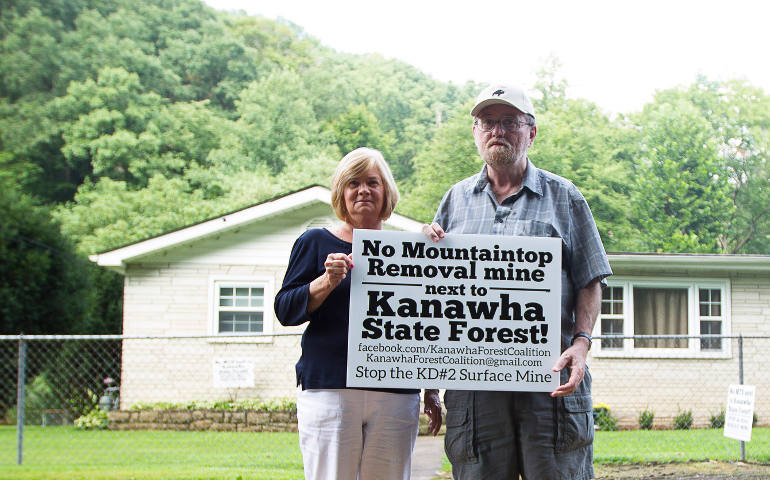
Stephen and Virginia Comer of Loudendale, W. Va., hold a sign voicing their protest against mountaintop removal coal mining, Aug. 18. The couple lives near Kanawha State Forest, and are concerned their home will be endangered by flooding from mining on the forest's edge. (CNS photo/Tyler Orsburn)
Stephen and Virginia Comer hardly see themselves as environmental activists.
The Comers, both 63, have been married 44 years and have found themselves, however, to be part of a group challenging the expansion of a surface coal mine near the home and a state forest used by birdwatchers, hikers, bikers and scouting groups.
It comes down to protecting their home of 17 years in Loudendale, an unincorporated community in a hollow south of Charleston, the state capital, so they can enjoy their retirement without worry.
Their concern focuses on the West Virginia Department of Environmental Protection and the permit the agency issued in May to allow Keystone Industries to expand surface mining for coal on Middlelick Mountain on the perimeter of the Kanawha State Forest. They learned from the Kanawha State Forest Coalition that opening an additional 413 acres to mining would leave the hollow more susceptible to flooding and polluted air and their home vulnerable to blasting.
Surface mining is another name for mountaintop removal mining, in which trees are clear cut, topsoil is removed and the tops of mountains are dynamited to expose rich coal seams. The process is highly mechanized, requiring less labor and less time to extract the coal. The process also can increase rainwater runoff from the mountain sites.
"I'm concerned with water and I'm concerned with flooding," said Stephen Comer, a retired electrician who has chronic obstructive pulmonary disease, or COPD, brought on by years of work in dusty and, at times, asbestos-laden buildings. The disease requires that he use supplemental oxygen.
The Comers dealt with flooding once. Their neat and modest home sustained significant damage when a normally placid tributary of Davis Creek just outside their fenced backyard became a torrent during an hours-long downpour in November 2003. Their basement was underwater and another room was heavily damaged in an unusual weather event long before mountaintop removal mining began.
"That's what scares me now," Virginia told Catholic News Service. "It means there will be no vegetation to hold back the water. I don't sleep now if it rains hard for a long time."
Besides the greater flood risk, the Comers are concerned about the dust that inevitably comes when workers dynamite the mountain. "It will go a long ways," Stephen said. "I can't breathe now."
The Kanawha State Forest Coalition maintains that the permit was issued with virtually no opportunity for public comment and that regulators based their decision on outdated soil sample studies. The coalition also argues that blasting is permitted within 600 feet of the forest's edge and within 1,500 feet of some Loudendale homes.
For their part, the state's Department of Environmental Protection officials said they followed proper protocols before issuing the permit and worked to ensure that mining is done as safely as possible with as little impact as possible on the forest and property owners.
Since May, Keystone has transferred the permit to a partner company, Revelation Energy. Plans called for clear cutting the forest, removing the topsoil and exploding dynamite strategically placed in the mountain to expose the rich coal seams. The company has said it will erect signs warning people when blasting is occurring in areas nearest the forest.
The company projects the mine will yield 7 million tons of coal over 10 years once the mining starts.
Tom Scholl, CEO of Keystone Industries, did not return messages left by CNS.
Loudendale residents have joined rallies at the state capital in Charleston seven miles away and have placed signs in their yards calling for the permit to be rescinded. They also have gained allies from some Charleston area ministers.
Loudendale resident Henry Thomas, 78, has numerous concerns about the expansion. Some are practical and some are related to preserving the environment.
"I don't want the noise. I don't want the rocks. I don't want the dust flying through the air," said Thomas, a retired carpenter who has lived in the hollow since 1965. His home is about a half-mile from the forest.
Thomas also expressed concern for the effect of blasting on wildlife, including bats, owls and invertebrates.
Daile Boulis, 53, another Loudendale resident, told CNS she welcomed the challenge to the permit.
"There's a culture here of being bullied by the coal companies," she said. "I'm just trying to save our home, I really am, and our way of life out here. I won't be bullied."
Several ministers have joined the coalition in support of the residents. Their concern is that the land will sufferable irreparable harm if the mining -- and blasting -- is permitted. Neither Bishop Michael J. Bransfield of Wheeling-Charleston nor the Catholic Conference of West Virginia has taken stands on individual mining projects.
The West Virginia Council of Churches, whose membership includes the statewide Catholic diocese, has weighed in on mountaintop removal mining specifically. In a 2007 statement that was revised in 2011, the council called for protecting the state's temperate forests and for upholding laws and related rules that govern surface mining.
The churches said the lives of miners working at surface mines and residents near such operations must be the highest priority.
"Mountaintop removal mining may be more cost effective for coal companies. But scholarly studies are providing troubling evidence that the method is extremely expensive to the health of people living in mountain communities. As we value the lives of our people, we cannot in good conscience condone the future well-being and life prospects of our children being disregarded for the sake of cheap electricity and modest amounts of employment," the updated statement said.
"The present and future harm to our people, especially the health and well-being of our children, and to our state's air and water are unacceptable, and we urge the industry to immediately begin to seek and implement alternative models of production," it concluded.
Patterson Lyles, pastor of Kanawha United Presbyterian Church, said in a roundtable interview with CNS that humanity is called to protect what God has created including the forests and mountain landscape of West Virginia.
"We are made in God's image," he said. “Dominion means caring for what God has made, just as God cares for us. God says it's very good. How many great events in the Bible took place on mountains? Abraham on the mountain, Moses on the mountain, Elijah on the mountain, Jesus on the mountain and here we're going to blow it up. It's unfathomable."
The state Department of Environmental Protection's action was challenged in court Oct. 2. Attorneys representing Loudendale residents asked the Circuit Court of Kanawha County to prohibit the department from permitting the new surface mine operations on Middlelick Mountain.
The filing outlined the lack of opportunity for comments from citizens in the department's process, and cited concerns over the environment, the effect on wildlife and the potential for flooding.
Kelley Gillenwater, the department's communications director, told CNS that her office spent five years working with Keystone to lessen the impact of mining on the surrounding land and negotiated several new provisions in response to resident concerns.
Some of the provisions include reducing the size of the mine from 598 acres to 413 acres; eliminating surface mining on two coal seams on the forest side of the site and increasing the buffer from the state minimum of 300 feet to 588 feet; requiring the side facing the forest to be mined last to limit the time park visitors can see the operation; and placing rock and dirt from the new site on to the existing mine site.
Gillenwater said she could not otherwise comment because of the litigation.
Editor's Note: This is the fifth story in a six-part Catholic News Service series examining mountaintop removal mining and poverty in Appalachia. Check Eco Catholic for past and upcoming stories in the series, or sign up for email alerts to receive them in your inbox.


